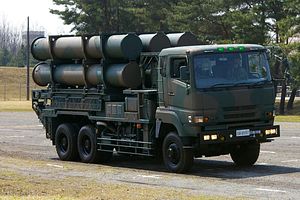The Japanese government is developing a new land-to-sea missile to reinforce the defenses of remote Japanese-controlled islets in the East China Sea known as the Senkaku in Japan and the Diaoyu in China, the Yomiuri Shimbun reports on August 14. The Japan-administered Senkaku Islands are also claimed by both China and Taiwan.
Japan has not revealed many details about the new weapon system except that it will have an approximate range of 300 kilometers (186 miles), use solid fuel, and is slated to be deployed by 2023. Funding for the new missile will be included in the fiscal year 2017 defense budget request and it will solely be developed and produced in Japan.
“The new missile will be mounted on a vehicle, making it easy to transport and change positions. It will have a guidance system using the global positioning system (GPS) or other means, and be capable of striking targets, such as other countries’ warships deployed around remote islands, from nearby islands,” the Yomiuri Shimbun reveals.
The new missile will supplement the Type 12 subsonic anti-ship missile, an upgraded variant of the Mitsubishi Heavy Industries’ Type 88 surface-to-ship missile with a reported range of 200 kilometers (124 miles), currently in service with the Japan Ground Self-Defense Force (GSDF). The Type 12 missile is carries by a transporter erector launcher, each carrying six missiles.
According to Yomiuri Shimbun, the new missile system could also be used for reoccupying islands:
The new surface-to-ship missile would also be effective if a remote island is occupied. When GSDF units conduct landing operations, they currently focus on naval gunfire from destroyers with a short firing range or dropping bombs from fighter jets. That involves a high risk of being counterattacked. The new missile would make it possible to assist the GSDF landing units from nearby islands.
The new coastal missile batteries will likely be stationed on Miyako Island in Okinawa prefecture about 170 kilometers (105 miles) from the Senkaku Islands, and Yonaguni Island, part of Okinawa Prefecture in the East China Sea, located 150 kilometers (90 miles) south of the disputed Senkaku/Diaoyu islands and 100 kilometers (62 miles) east of Taiwan.
In March, the GSDF finished construction of a permanent new radar station on Yonaguni Island. As I reported (See: “New Radar Facility: Japan Expands Military Presence in East China Sea”), the new radar station was deployed to improve Japan’s air and maritime domain awareness around the Nansei (aka Ryukyu) island chain and to provide an early warning system in the event of conflict with China.
Tensions between China and Japan have progressively been rising in the East China Sea this year. This month, six China Coast Guard ships, accompanied by more than two hundred fishing vessels, entered disputed waters around the Senkaku/Diaoyu Islands. China has also installed new radar equipment on a gas platform in the East China Sea in August, according to Japan’s Ministry of Foreign Affairs. Both countries have yet to delimit their exclusive economic zones in the disputed waters.
The Japan Air-Self Defense Force (JASDF) had to scramble its fighter jets 571 times during fiscal year 2015 to intercept Chinese military aircraft approaching or intruding Japanese airspace. As a response, for the first time in 50 years, the JASDF has stood up a new air wing consisting of Mitsubishi F-15J all-weather air superiority fighters to fend off Chinese advances—in particular in the East China Sea (See: “Japan Forms New Air Wing to Fend off China’s Advances in East China Sea”).

































